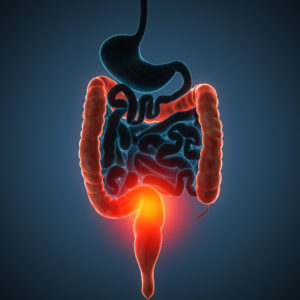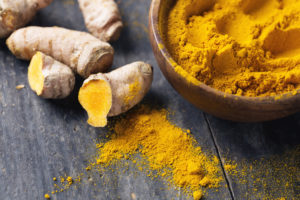 Ulcerative colitis is a chronic disease of the large intestine, also known as the colon, in which the lining of the colon becomes inflamed and develops tiny open sores, or ulcers, that produce pus and mucous. The combination of inflammation and ulceration can cause abdominal discomfort and frequent emptying of the colon.
Ulcerative colitis is a chronic disease of the large intestine, also known as the colon, in which the lining of the colon becomes inflamed and develops tiny open sores, or ulcers, that produce pus and mucous. The combination of inflammation and ulceration can cause abdominal discomfort and frequent emptying of the colon.
Ulcerative colitis is the result of an abnormal response by body’s immune system. Normally, the cells and proteins that make up the immune system protect from infection. In people with inflammatory bowel disease (IBD), however, the immune system mistakes food, bacteria, and other materials in the intestine for foreign or invading substances. When this happens, the body sends white blood cells into the lining of the intestines, where they produce chronic inflammation and ulcerations.
The disease usually begins in the rectal area, and may involve the entire large intestine over time. Because ulcerative colitis is a chronic condition, symptoms usually develop over time, rather than suddenly.
Ulcerative colitis is a global condition affecting people world over. It may affect any age group, although there are peaks at ages 15 – 30 and then again at ages 50 – 70. Male & Females are equally affected.
About half of all the patients with ulcerative colitis experience mild symptoms. Variability of symptoms reflects differences in the extent of disease (the amount of the colon and rectum that are inflamed) and the intensity of inflammation. Generally, patients with inflammation confined to the rectum and a short segment of the colon adjacent to the rectum have milder symptoms and a better prognosis than patients with more widespread inflammation of the colon.
The main symptoms are:
- Abdominal Discomfort Or Cramps
- Rectal Bleeding
- Diarrhea
- Other symptoms include
- anemia
- fatigue
- fever
- nausea
- weight loss
- loss of appetite
- rectal bleeding
- Abdominal sounds
- Mouth ulcers
- loss of body fluids and nutrients
- skin lesions
- growth failure in children
UC can also cause problems such as joint pain, eye irritation, kidney stones, liver disease, and osteoporosis.
The symptoms of ulcerative colitis do tend to come and go, with fairly long periods in between flare-ups in which patients may experience no distress at all. These periods of remission can span months or even years, although symptoms do eventually return. The unpredictable course of ulcerative colitis may make it difficult for physicians to evaluate whether a particular course of treatment has been effective or not.
The different types of ulcerative colitis are classified according to the location and the extent of inflammation:
- Ulcerative proctitis – In this form of ulcerative colitis, inflammation is confined to the area closest to the anus (rectum), and for some people, rectal bleeding may be the only sign of the disease. Others may have rectal pain and a feeling of urgency. This form of ulcerative colitis tends to be the mildest.
- Proctosigmoiditis – This form involves the rectum and the lower end of the colon, known as the sigmoid colon. Bloody diarrhea, abdominal cramps and pain, and an inability to move the bowels in spite of the urge to do so (tenesmus) are common problems associated with this form of the disease.
- Left-sided colitis – As the name suggests, inflammation extends from the rectum up through the sigmoid and descending colon, which are located in the upper left part of the abdomen. Signs and symptoms include bloody diarrhea, abdominal cramping and pain on the left side, and unintended weight loss.
- Pancolitis or universal colitis – refers to inflammation affecting the entire colon (right colon, left colon, transverse colon and the rectum). Symptoms of pancolitis include bloody diarrhea, abdominal pain and cramps, significant weight loss, fatigue, fever, and night sweats. Patients of this type suffer more severe disease and are more difficult to treat than those with more limited forms of ulcerative colitis.
- Fulminant colitis. This rare, life-threatening form of colitis affects the entire colon and causes severe pain, profuse diarrhea and, sometimes, dehydration and shock. People with fulminant colitis are at risk of serious complications, including colon rupture and toxic megacolon, a condition that causes the colon to rapidly expand.
The causes of ulcerative colitis are not known. To date, there has been no convincing evidence that it is caused by infection or is contagious.
People with this condition have problems with the immune system, but it is not clear whether immune problems cause this illness. Although stress and certain foods can trigger symptoms, they do not cause ulcerative colitis.
Researchers believe the following factors may play a role in causing ulcerative colitis:
- overactive intestinal immune system
- genes
- environment
Research suggests that ulcerative colitis could be triggered by an interaction between a virus or bacterial infection in the colon and the body’s immune response.
- Typically, the cells and proteins that make up your immune system protect you from infection.
- A normal immune response would cause temporary inflammation to combat an illness or infection. The inflammation would then go away once you are healthy and free of the illness.
- In ulcerative colitis patients, the inflammation persists long after the immune system should have finished its job. The body continues to send white blood cells into the lining of the intestines, where they produce chronic inflammation and ulcers.
Some people believe eating certain foods, stress, or emotional distress can cause ulcerative colitis. Emotional distress does not seem to cause ulcerative colitis. A few studies suggest that stress may increase a person's chance of having a flare-up of ulcerative colitis. Also, some people may find that certain foods can trigger or worsen symptoms.
Risk factors include a family history of ulcerative colitis, or Jewish ancestry.
Possible complications of ulcerative colitis include:
- Severe bleeding
- A hole in the colon (perforated colon)
- Colon narrowing
- Severe dehydration
- Inflammation of the joints (arthritis)
- Ankylosing spondylitis
- Liver disease (rare)
- Kidney stones
- Osteoporosis
- Inflammation of skin
- Sores (lesions) in the eye
- An increased risk of colon cancer
- A rapidly swelling colon (toxic megacolon)
The diagnosis of ulcerative colitis is suggested by the symptoms of abdominal pain, rectal bleeding, and diarrhea. As there is no gold standard for diagnosis, the ultimate diagnosis relies on a combination of symptoms, the appearance of the colonic lining at the time of endoscopy, histologic features of biopsies of the colonic lining, and studies of stool to exclude the presence of infectious agents that may be causing the inflammation.
Tests to diagnose ulcerative colitis often include:
- Barium enema
- Complete blood count (CBC), C-reactive protein (CRP), Sedimentation rate (ESR), Liver function test (LFT), Electrolytes, Renal function tests
- Stool analysis (specifically for a protein called calprotectin)
- Colonoscopy with biopsy
- X – ray
- capsule endoscopy
- CT and MRI enterography
Ulcerative Colitis vs. Crohn’s Disease
Ulcerative colitis and Crohn’s disease share similar symptoms and they are both types of inflammatory bowel disease (IBD), but they are not the same illness and they affect different areas of the GI tract.
- Can affect any part of the GI tract from the mouth to the anus
- Can affect the entire thickness of the bowel wall
- Only the colon and rectum (also known as the large intestine) are affected
- Affects the inner-most lining of the large intestine
Ayurveda Perspective & Management of Ulcerative Colitis

As per Ayurveda, Ulcerative colitis can be considered as ‘Pittaja Grahani’.
In Ayurveda, it is known that perfect health exists when the three fundamental energies (doshas: Vata, Pitta and Kapha) are in balance. Out of these three, when Pitta dosha gets imbalnced, vitiates intestines and causes Pittaja Grahani.
Pitta energy fuels all the biochemical activities, including transformation, digestion, metabolism and assimilation. Pitta is responsible for all the enzymatic and endocrine activity, regulation of body temperature, pigmentation, vision, intelligence, vitality, ambition, courage and understanding. The key qualities of pitta are hot, quick, light, liquid, spreading, slightly oily and fleshy smelling.
Causes of Pittaja Grahani disease are Mandagi (poor appetite and poor digestion), irregular, improper and irrelevant diet habits, heavy to digest or indigestible foods, junk food, Pitta aggravating diets like excess of spicy, pungent, acidic, sour, alkaline nature foods, food items which produces burning sensation in the body, exposure to excess hot climate, alcohol, smoking, excess anger etc. Non-following of the healthy diet habits (Pathya) in certain digestive disorders, especially the conditions of post diarrhea and irritable bowels, are also one of the causes of this disease.
Pittaja Grahani produces the classical symptoms of Ulcerative colitis. Vitiation of Pitta, when reaches extreme will causes severe inflammation, ulceration and rectal bleeding (active phase or flare-up).
At CHARAKA, we offer very effective treatment for Ulcerative colitis based on the classical principle of Ayurveda and our research. Our treatment of Ulcerative colitis is focused in healing the ulcers and restoring the normal function of colon and maintaining the overall health of the digestive system.
Treatment involves Shamana chikitsa (internal medicines), Shodana chikitsa (Panchakarma therapy), life style modifications and very strict diet regime. In more severe case Panchakarma therapy plays a vital role as it quickly detoxifies & rejuvenates the digestive system, controls the inflammation, rectal bleeding and heals the ulcerations.
Usually results are very good with Ayurvedic line of treatment. Early cases tend to respond quickly than chronic. If patient can stick to all the guidelines as advised, even complete cure can also be achieved.

